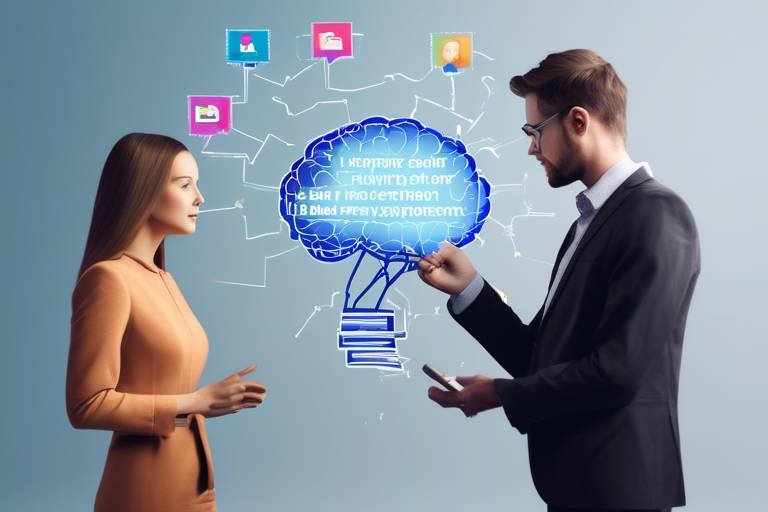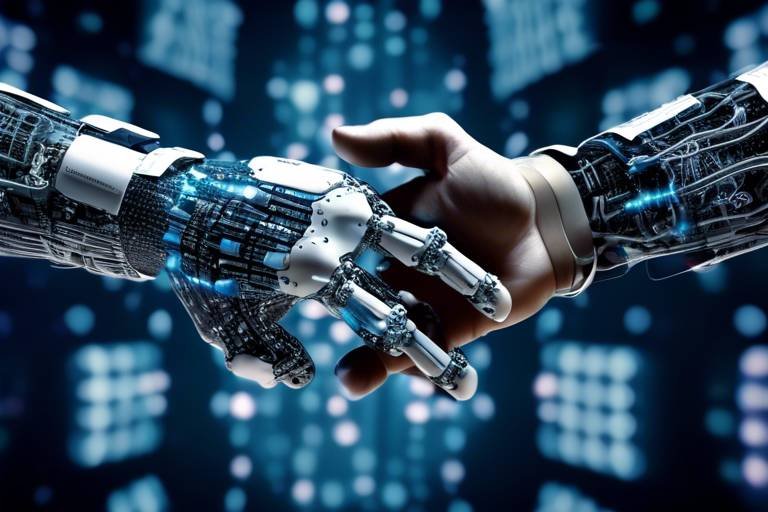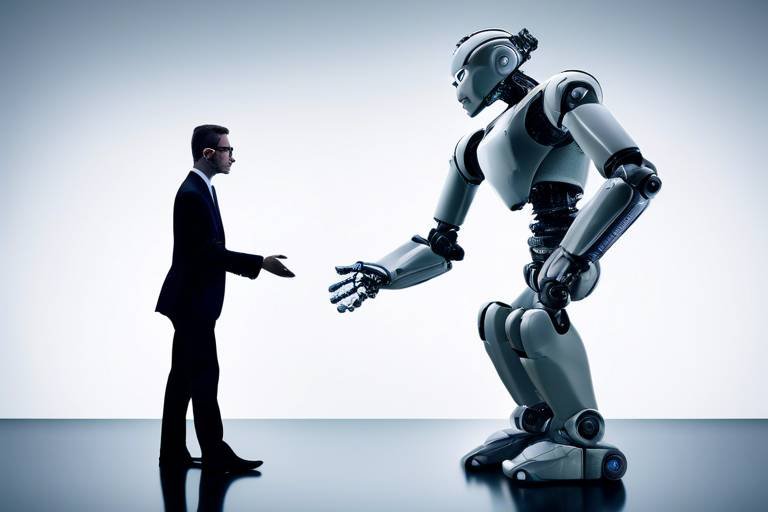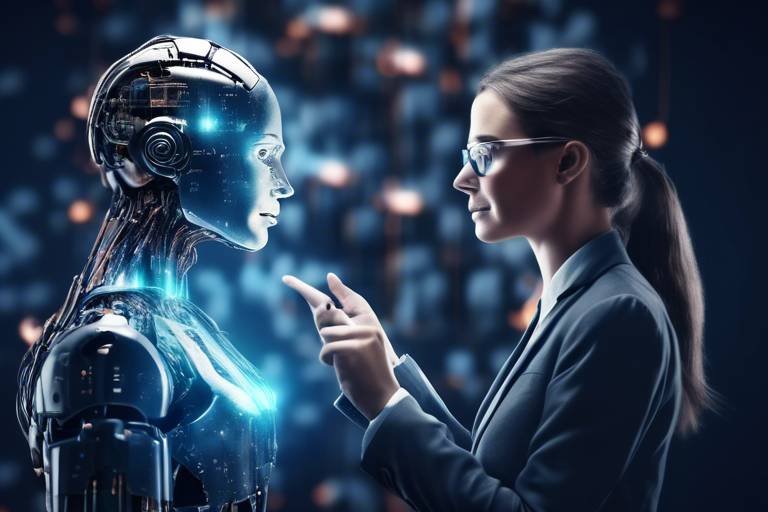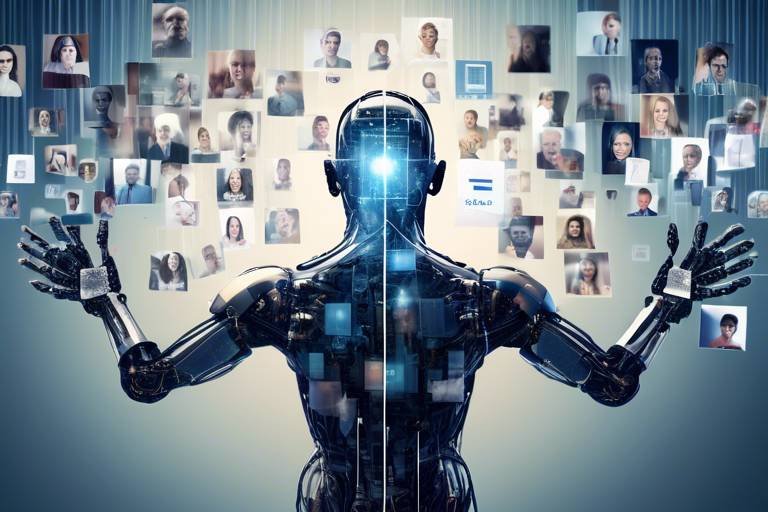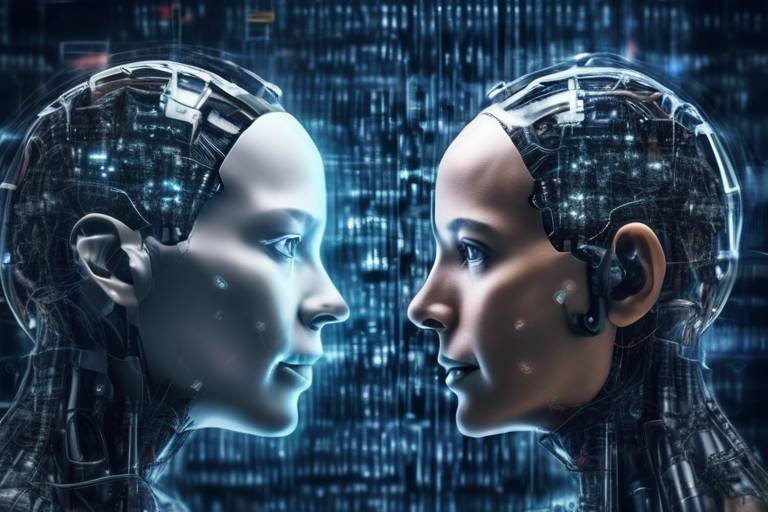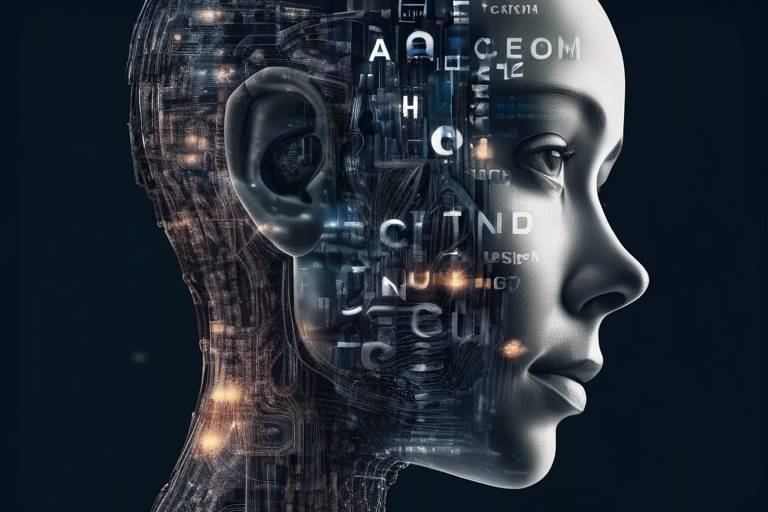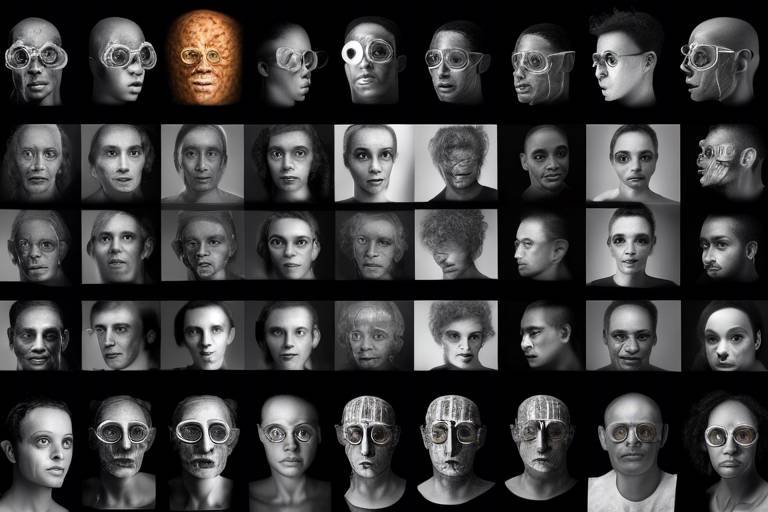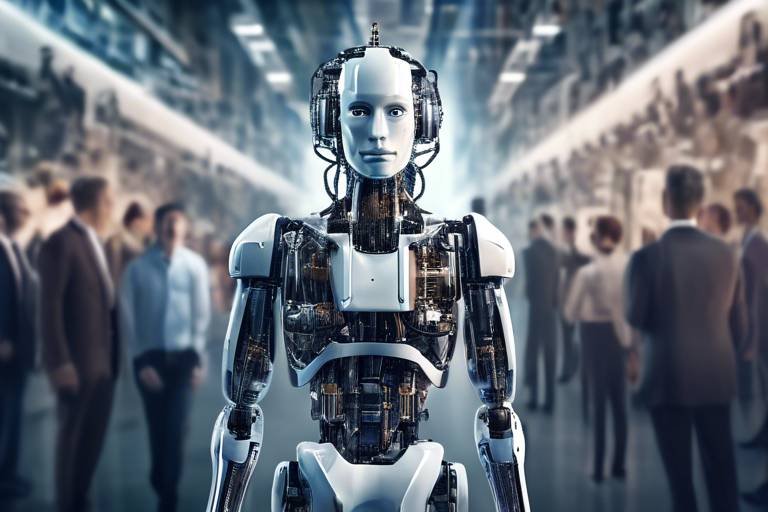Maximising Productivity: The Confluence of AI and Human Collaboration
In today's fast-paced world, the quest for productivity feels like a never-ending race. But what if I told you that the secret sauce to achieving peak productivity lies not just in hard work, but in the synergy between artificial intelligence (AI) and human collaboration? Imagine a workplace where machines take care of the mundane, freeing up our creative minds to innovate and solve problems. This is not a distant dream; it's a reality we can cultivate right now.
Artificial intelligence is not just a buzzword thrown around in tech circles; it has become an essential tool that can transform the way we work. From automating repetitive tasks to providing data-driven insights, AI can streamline workflows and enhance efficiency. For instance, think about how much time we spend on data entry or scheduling meetings. With AI tools handling these tasks, we can redirect our energy toward more meaningful work that requires human touch and creativity.
However, let’s not forget the human element. While AI can process information at lightning speed, it lacks the emotional intelligence, creativity, and nuanced understanding that only humans possess. This is where collaboration comes into play. When teams come together, combining their unique skills and perspectives, they can tackle complex challenges that AI alone cannot solve. It's like a well-oiled machine: the gears (AI) may be efficient, but the engine (human collaboration) drives the innovation forward.
To truly maximize productivity, organizations must foster a collaborative culture. This involves creating an environment where open communication and teamwork are not just encouraged but celebrated. By doing so, companies can harness the full potential of AI and human collaboration, leading to improved morale and productivity. Imagine brainstorming sessions where AI tools provide real-time data analysis, allowing teams to make informed decisions on the fly. This dynamic interplay can spark creativity and lead to groundbreaking ideas.
In this article, we will delve deeper into how AI enhances productivity, the importance of human collaboration, and the challenges that come with integrating these two forces. We will explore effective strategies for building a collaborative culture, the tools that can facilitate this process, and how organizations can ensure ethical AI usage. So, buckle up as we navigate through this fascinating intersection of technology and teamwork!
Artificial intelligence plays a crucial role in streamlining tasks, automating repetitive processes, and providing insights that help teams make informed decisions, ultimately boosting overall productivity. With AI handling the more mundane aspects of work, employees can focus on higher-level tasks that require critical thinking and creativity. Think of AI as your personal assistant, tirelessly working behind the scenes to ensure everything runs smoothly.
Effective collaboration among team members fosters creativity and innovation, enabling organizations to leverage diverse perspectives and skills to solve complex problems and achieve their goals. When people from different backgrounds come together, they bring a wealth of experiences and ideas that can lead to innovative solutions. This collaborative spirit is essential in today's competitive landscape, where the ability to adapt and innovate is key to success.
Establishing a culture that encourages open communication and teamwork is essential for maximizing the benefits of AI and human collaboration, leading to improved morale and productivity. Organizations should prioritize team-building activities and create platforms for employees to share ideas freely. When employees feel valued and heard, their engagement levels soar, which directly impacts productivity.
Utilizing digital tools and platforms can facilitate seamless communication and collaboration among team members, breaking down silos and enhancing productivity across the organization. Tools like Slack, Trello, and Microsoft Teams allow for real-time collaboration, making it easier for teams to work together, regardless of their physical location. These platforms can serve as the backbone of a collaborative culture, ensuring that everyone is on the same page.
Investing in training programs that focus on collaboration skills and AI literacy ensures that employees are equipped to work effectively with AI technologies and each other. Organizations should provide ongoing training sessions and workshops that help employees understand how to leverage AI tools for their benefit. This not only increases efficiency but also empowers employees to take ownership of their roles.
Finding the right balance between AI-driven automation and human creativity is vital for optimizing productivity while ensuring that human insights and emotional intelligence remain integral to decision-making. While AI can analyze data and predict trends, it is the human touch that can interpret these findings and apply them in a way that resonates with others.
Despite the potential benefits, there are challenges in integrating AI with human collaboration, including resistance to change, skill gaps, and ethical considerations that must be addressed. Organizations must be proactive in identifying and overcoming these hurdles to create a truly collaborative environment.
Addressing employee concerns and resistance to AI adoption through transparent communication and demonstrating the benefits can help organizations transition smoothly to a collaborative model. When employees understand how AI can enhance their work rather than replace them, they are more likely to embrace these changes.
Establishing guidelines and frameworks for ethical AI use is essential to maintain trust and fairness in AI-human collaboration, ensuring that technology serves humanity's best interests. Organizations should prioritize ethical considerations in their AI strategies to build a culture of trust and accountability.
- What is the main benefit of AI in the workplace? AI streamlines tasks, automates repetitive processes, and provides valuable insights, thereby enhancing overall productivity.
- How does human collaboration impact innovation? Collaboration brings together diverse perspectives and skills, fostering creativity and enabling teams to solve complex problems.
- What tools can enhance workplace collaboration? Tools like Slack, Trello, and Microsoft Teams facilitate seamless communication and collaboration among team members.
- How can organizations overcome resistance to AI? Transparent communication and demonstrating the benefits of AI can help alleviate employee concerns and encourage adoption.
- Why is ethical AI use important? Ethical AI use maintains trust and fairness in AI-human collaboration, ensuring that technology serves humanity's best interests.

The Role of AI in Enhancing Productivity
Artificial Intelligence (AI) is not just a buzzword; it's a revolutionary force that is reshaping the way we work. Imagine a world where mundane tasks are handled by intelligent systems, leaving humans free to focus on creativity, strategy, and innovation. That's the promise of AI in enhancing productivity! With the ability to streamline tasks and automate repetitive processes, AI acts as a powerful ally in the workplace. Think of AI as your personal assistant that never tires, always ready to crunch numbers, analyze data, and provide insights that can lead to informed decision-making.
For instance, AI can analyze vast amounts of data in seconds, something that would take humans hours, if not days. This capability allows teams to make quicker decisions based on real-time data analysis. By identifying trends and patterns, AI provides valuable insights that can help organizations pivot their strategies effectively. This not only boosts overall productivity but also fosters a culture of agility and responsiveness within teams.
Moreover, AI tools can enhance communication and collaboration among team members. Imagine a scenario where AI-powered chatbots manage routine inquiries, freeing up valuable time for human employees to engage in more meaningful interactions. This dynamic not only improves efficiency but also enhances team morale, as employees feel more empowered to contribute their unique skills and insights.
Let's break down some of the key areas where AI enhances productivity:
- Automating Repetitive Tasks: Tasks like data entry, scheduling, and basic customer service inquiries can be automated, allowing employees to focus on higher-level responsibilities.
- Data Analysis: AI can process and analyze data at unprecedented speeds, uncovering insights that inform business decisions.
- Predictive Analytics: By forecasting trends and behaviors, AI helps organizations anticipate customer needs and market shifts, enabling proactive strategies.
- Enhanced Communication: AI tools facilitate better communication and collaboration, ensuring that everyone is on the same page and reducing misunderstandings.
In a world where time is money, AI's ability to optimize workflows and enhance productivity is invaluable. However, it's essential to remember that while AI can take over many tasks, the human touch—our creativity, emotional intelligence, and problem-solving skills—remains irreplaceable. The most successful organizations will be those that leverage AI not as a replacement for human workers but as a tool that enhances their capabilities.
Ultimately, the integration of AI into the workplace is not just about technology; it's about creating a synergistic environment where both AI and human talents work hand in hand. As we embrace this new era of productivity, we must also remain mindful of the challenges and opportunities that lie ahead. The journey towards maximizing productivity through AI is just beginning, and the potential is limitless!
- What tasks can AI automate to enhance productivity? AI can automate tasks such as data entry, scheduling, and customer service inquiries, allowing employees to focus on higher-level responsibilities.
- How does AI improve decision-making? AI analyzes vast amounts of data quickly, providing insights that enable teams to make informed decisions based on real-time information.
- Can AI replace human jobs? While AI can take over repetitive tasks, it is designed to enhance human capabilities rather than replace them, allowing for more creative and strategic work.

Human Collaboration: The Key to Innovation
In today's fast-paced world, the ability to innovate is not just a luxury; it's a necessity. When it comes to driving innovation, human collaboration stands out as a critical component. Think of collaboration as the spark that ignites creativity. When individuals come together, sharing their unique insights and experiences, they create a powerful synergy that leads to groundbreaking ideas and solutions. It's like a potluck dinner where everyone brings their favorite dish; the combination of flavors creates a feast that no single dish could achieve alone.
Effective collaboration among team members fosters an environment where creativity can flourish. Each person brings their own set of skills and perspectives, which can lead to innovative solutions for complex problems. For instance, consider a team of engineers, designers, and marketers working together on a new product. The engineers might focus on the technical feasibility, while the designers bring aesthetic appeal, and the marketers ensure that the product meets customer needs. When these diverse talents collaborate, they can create a product that is not only functional but also visually appealing and market-ready.
However, collaboration goes beyond just bringing people together; it involves creating a culture that encourages open communication and trust. This culture is essential for maximizing the benefits of collaboration, as it allows team members to express their ideas freely without fear of judgment. A study by the Harvard Business Review found that teams with a strong culture of collaboration were able to solve problems more effectively and produce higher-quality work. This is because when people feel safe to share their thoughts, they are more likely to contribute innovative ideas.
Establishing a collaborative culture requires intentional effort from leadership and team members alike. It begins with promoting values such as respect, inclusivity, and transparency. Leaders should model these behaviors, creating an environment where everyone feels valued. Regular team-building activities, brainstorming sessions, and feedback loops can also help strengthen collaboration. These practices encourage team members to engage with one another, share their ideas, and challenge each other constructively.
To further enhance collaboration, organizations can leverage various digital tools and platforms. These tools facilitate seamless communication, allowing team members to connect regardless of their physical location. For example, platforms like Slack, Trello, and Zoom enable teams to collaborate in real-time, share documents, and manage projects efficiently. By breaking down silos and enhancing productivity, these tools can significantly contribute to a collaborative culture.
In conclusion, human collaboration is the bedrock of innovation. It harnesses the collective intelligence of diverse individuals, creating a fertile ground for new ideas to take root. By fostering a collaborative culture and utilizing the right tools, organizations can unlock their full potential, leading to groundbreaking innovations that drive success. So, are you ready to embrace the power of collaboration in your organization?
- What are the benefits of human collaboration? Human collaboration enhances creativity, leads to innovative solutions, and improves problem-solving abilities.
- How can organizations promote a collaborative culture? Organizations can promote a collaborative culture by encouraging open communication, providing team-building activities, and utilizing digital collaboration tools.
- What tools can facilitate collaboration? Tools like Slack, Trello, and Zoom can facilitate communication and project management among team members.
- Why is diversity important in collaboration? Diversity brings different perspectives and ideas, which can lead to more innovative solutions and better decision-making.

Building a Collaborative Culture
Creating a collaborative culture within an organization is akin to nurturing a garden; it requires time, effort, and the right conditions to flourish. A workplace that fosters collaboration not only enhances productivity but also cultivates a sense of belonging among employees. When team members feel valued and included, they are more likely to contribute their ideas and perspectives, leading to innovative solutions and improved outcomes. But how do we build this culture? It starts with open communication. Encouraging employees to share their thoughts without fear of criticism is crucial. This can be achieved through regular team meetings, brainstorming sessions, and feedback loops where everyone’s voice is heard and appreciated.
Moreover, it's essential to recognize that collaboration isn't just about working together; it's about understanding and leveraging the diverse strengths of each team member. Just as a symphony orchestra thrives on the unique talents of its musicians, a team can achieve remarkable results when each member plays to their strengths. This means identifying individual skills and aligning them with team goals, fostering an environment where everyone feels empowered to contribute their best work.
To further enhance collaboration, organizations should consider implementing team-building activities. These activities can range from casual social gatherings to structured workshops aimed at improving teamwork skills. For instance, activities that promote problem-solving or creative thinking can significantly boost team cohesion. Additionally, utilizing digital collaboration tools can break down barriers and facilitate seamless communication. Tools like Slack, Microsoft Teams, or Asana can help teams stay connected, share ideas in real-time, and keep track of projects, ultimately leading to a more integrated work environment.
It's also vital to establish clear goals and expectations. When everyone understands the objectives, they can work together more effectively towards achieving them. This clarity not only aligns efforts but also fosters accountability among team members. Organizations can visualize these goals through
tables or- lists, making them more accessible and easier to track. For example:
| Goal | Action Steps | Deadline |
|---|---|---|
| Improve Team Communication | Implement weekly check-ins | Ongoing |
| Enhance Problem-Solving Skills | Conduct monthly workshops | Monthly |
| Increase Project Efficiency | Adopt project management tools | End of Q1 |
Lastly, fostering a culture of collaboration requires strong leadership. Leaders should model collaborative behavior, demonstrating how to work together effectively and encouraging their teams to do the same. By being approachable and supportive, leaders can create an environment where employees feel safe to share ideas and take risks. Remember, a collaborative culture is not built overnight; it’s a continuous journey that evolves with the organization. As we embrace this journey, we not only enhance productivity but also create a workplace where innovation thrives and employees feel truly engaged.
- What is a collaborative culture? A collaborative culture is an environment where teamwork, open communication, and mutual respect are prioritized, allowing employees to work together effectively towards common goals.
- How can I encourage collaboration in my team? You can encourage collaboration by promoting open communication, recognizing individual strengths, implementing team-building activities, and utilizing digital collaboration tools.
- What role does leadership play in fostering collaboration? Leaders play a crucial role by modeling collaborative behavior, providing support, and creating an environment where employees feel safe to share ideas and take risks.

Tools for Enhancing Collaboration
In today's fast-paced work environment, leveraging the right tools can be the game-changer that transforms how teams collaborate and communicate. With the integration of artificial intelligence and human effort, organizations can create a workspace that not only enhances productivity but also fosters innovation. Imagine a bustling coffee shop where ideas flow as freely as the caffeine—this is the kind of dynamic atmosphere that effective collaboration tools can help cultivate.
One of the most powerful tools at our disposal is cloud-based collaboration platforms. These platforms allow team members to access documents, share files, and communicate in real-time, regardless of their physical location. Tools like Google Workspace and Microsoft Teams serve as digital hubs where brainstorming sessions can happen without the constraints of traditional office walls. They enable teams to work together seamlessly, as if they were sitting around the same table, even if they are miles apart.
Moreover, project management tools such as Trello and Asana can dramatically enhance collaboration by providing a clear visual representation of project timelines and responsibilities. These tools help team members understand their roles and how they contribute to the larger objectives. Picture a well-organized train station where every train is on schedule—this is how effective project management can keep collaboration on track.
Additionally, incorporating video conferencing tools like Zoom or Microsoft Teams can bridge the gap between remote and in-office employees. These platforms not only facilitate face-to-face interactions but also allow for screen sharing and collaborative discussions in real-time. It’s like having a virtual meeting room where everyone can contribute, share ideas, and build on each other's thoughts, making the collaborative process much more engaging.
But let's not forget about the importance of feedback and communication tools. Platforms like Slack and Discord can serve as informal communication channels where team members can share quick updates, ask questions, or even celebrate small wins together. This kind of open communication fosters a sense of community and belonging, which is essential for a collaborative culture. Think of it as the water cooler conversation that keeps team spirits high and ideas flowing.
In conclusion, the right tools can significantly enhance collaboration within teams. By utilizing a combination of cloud-based platforms, project management tools, video conferencing, and communication channels, organizations can create a collaborative environment that not only boosts productivity but also nurtures innovation. The synergy between AI and human collaboration is not just about efficiency; it’s about creating a workplace where ideas can thrive and grow.
- What are the main benefits of using collaboration tools?
Collaboration tools streamline communication, enhance project management, and foster a sense of community among team members, ultimately leading to increased productivity and innovation. - Can collaboration tools be used effectively in remote work environments?
Absolutely! Many collaboration tools are designed specifically for remote work, allowing teams to connect and collaborate regardless of their physical locations. - How do I choose the right collaboration tools for my team?
Consider your team's specific needs, the size of your team, and the types of projects you work on. It’s often helpful to trial a few tools to see which ones fit best.

Training and Development
Investing in training programs that focus on collaboration skills and AI literacy is essential for equipping employees to work effectively with AI technologies and each other. In today's rapidly evolving work environment, it is no longer enough to simply understand how to operate a computer or software. Employees must also grasp how to leverage artificial intelligence as a tool to enhance their productivity. This means understanding not just the "how" but also the "why" behind AI applications in the workplace.
Imagine a world where employees are not just passive users of technology but active participants in shaping their work processes. This can be achieved through targeted training that emphasizes both technical skills and interpersonal collaboration. For instance, workshops that combine hands-on AI training with team-building exercises can foster an environment where employees feel empowered to share ideas and innovate.
To illustrate the impact of effective training, consider the following table that compares productivity metrics before and after implementing training programs focused on AI and collaboration:
| Metric | Before Training | After Training |
|---|---|---|
| Project Completion Time | 12 weeks | 8 weeks |
| Employee Satisfaction | 65% | 85% |
| Innovation Proposals | 5 per quarter | 15 per quarter |
As shown, effective training can lead to significant improvements in key productivity metrics. Moreover, these programs should not be one-time events but rather ongoing learning opportunities. Continuous development ensures that employees stay updated with the latest AI advancements and collaboration tools, fostering a culture of lifelong learning.
In addition to formal training, organizations can encourage knowledge sharing through mentorship programs and collaborative projects. When seasoned employees share their expertise with newer team members, it creates a sense of community and belonging. This not only enhances individual skill sets but also builds a stronger, more cohesive team.
Ultimately, the goal of training and development is to create a workforce that is not only proficient in AI technologies but also adept at collaborating effectively. By doing so, organizations can harness the full potential of both AI and human creativity, leading to a more productive and innovative workplace.
- What is the importance of AI literacy in the workplace?
AI literacy helps employees understand how to use AI tools effectively, leading to better decision-making and increased productivity.
- How can organizations encourage collaboration?
By fostering an open culture, providing collaboration tools, and investing in team-building activities.
- What are the key components of an effective training program?
Effective training programs should include hands-on learning, continuous development, and opportunities for knowledge sharing.

Balancing AI and Human Input
In today's fast-paced work environment, finding the right balance between artificial intelligence and human creativity is essential for optimizing productivity. Think of AI as a powerful engine driving a car; it can take you far and fast, but without a skilled driver—our human input—the journey may become erratic or even dangerous. This balance is not just about using technology to automate tasks; it’s about leveraging the unique strengths of both AI and humans to create a synergistic workflow that enhances decision-making and fosters innovation.
AI excels at processing vast amounts of data quickly and efficiently, identifying patterns, and providing insights that might escape human notice. However, it lacks the emotional intelligence and creativity that humans bring to the table. For instance, while AI can analyze customer feedback and suggest improvements, it’s the human team that can truly understand the emotional undertones and nuances behind those comments. This is where collaboration becomes key: by combining AI's analytical prowess with human empathy and creativity, organizations can achieve remarkable outcomes.
To effectively balance these elements, organizations should consider a few critical factors:
- Define Roles Clearly: Clearly delineating the roles of AI and human input helps prevent overlap and confusion. For example, AI can handle data analysis, while humans can focus on strategy and creative solutions.
- Encourage Continuous Learning: As AI technology evolves, so should the skills of the workforce. Training programs that enhance AI literacy among employees will empower them to utilize AI tools effectively.
- Foster an Open Mindset: Cultivating a culture that embraces change will help employees see AI as an ally rather than a threat. When teams understand the complementary nature of AI and human skills, they are more likely to engage with the technology positively.
Moreover, organizations should regularly assess the impact of AI on their workflows. By gathering feedback from team members on how AI tools are affecting their productivity and creativity, companies can make informed adjustments. This continuous feedback loop not only enhances productivity but also ensures that human insights remain integral to the decision-making process.
In summary, striking the right balance between AI and human input is crucial for maximizing productivity. By recognizing the strengths of both and creating an environment where they can thrive together, organizations can drive innovation and achieve their goals more effectively.
- What are the main benefits of balancing AI and human input? Balancing AI and human input leads to improved decision-making, enhanced creativity, and increased overall productivity.
- How can companies ensure their employees are comfortable with AI? Providing training and fostering an open culture that embraces change are key strategies to help employees feel comfortable with AI technologies.
- What role does emotional intelligence play in AI-human collaboration? Emotional intelligence is crucial for interpreting data and understanding the human aspects of decision-making, which AI alone cannot achieve.

Challenges in AI-Human Collaboration
As we dive deeper into the integration of artificial intelligence and human collaboration, it’s essential to acknowledge the hurdles that can impede this dynamic partnership. While the potential benefits are immense, the road to seamless collaboration is often fraught with challenges that organizations must navigate. One of the primary obstacles is the resistance to change. Many employees may feel threatened by AI technologies, fearing that their roles could be diminished or even rendered obsolete. This fear can lead to a lack of enthusiasm or outright opposition to adopting new systems, which ultimately hampers productivity.
Another significant challenge lies in the skill gaps that exist within the workforce. Not every employee is equipped with the necessary skills to work alongside AI tools effectively. This disparity can create a divide among team members, where some may thrive in a tech-savvy environment while others struggle to keep up. Organizations must invest in training programs to bridge these gaps, ensuring that all employees feel confident and capable in their roles.
Moreover, there are ethical considerations that cannot be overlooked when integrating AI into the workplace. Questions around data privacy, algorithmic bias, and the overall impact of AI on decision-making processes are paramount. Organizations must establish clear guidelines and frameworks to ensure that AI is used responsibly and ethically, maintaining trust among employees and clients alike. Without these measures, the very foundation of AI-human collaboration can be jeopardized, leading to skepticism and disengagement.
To illustrate these challenges further, consider the following table that summarizes the key obstacles organizations face:
| Challenge | Description |
|---|---|
| Resistance to Change | Employees may fear job loss or reduced importance due to AI, leading to reluctance in adopting new technologies. |
| Skill Gaps | Not all employees possess the necessary skills to work effectively with AI tools, creating disparities in productivity. |
| Ethical Considerations | The need for clear guidelines to address issues like data privacy and algorithmic bias is crucial for maintaining trust. |
In conclusion, while the collaboration between AI and humans holds great promise for enhancing productivity, organizations must proactively address these challenges. By fostering an environment of open communication, providing necessary training, and ensuring ethical practices, companies can pave the way for a more harmonious and productive workplace.
- What are the main challenges of AI-human collaboration? The main challenges include resistance to change, skill gaps, and ethical considerations.
- How can organizations overcome resistance to AI? Organizations can overcome resistance by engaging in transparent communication and demonstrating the benefits of AI.
- Why is ethical AI use important? Ethical AI use is crucial for maintaining trust and fairness, ensuring that technology benefits humanity rather than harms it.

Overcoming Resistance to Change
Change is often met with a wave of resistance, and when it comes to integrating artificial intelligence into the workplace, this resistance can be particularly pronounced. Employees may feel threatened by the idea of AI taking over their jobs or worry that they lack the necessary skills to work alongside these new technologies. To successfully navigate this transition, organizations must approach the situation with empathy and understanding.
First and foremost, communication is key. Leaders should engage in open dialogues with their teams, addressing any concerns and misconceptions about AI. For instance, sharing success stories where AI has complemented human efforts rather than replaced them can help to alleviate fears. Imagine a scenario where a marketing team uses AI to analyze consumer data, freeing them up to focus on creative campaigns. This not only enhances productivity but also highlights the collaborative potential of AI and human synergy.
Another effective strategy is to involve employees in the change process. When team members feel like they have a say in how AI is implemented, they are more likely to embrace it. This could involve soliciting feedback on which tasks they believe AI could assist with or even allowing them to participate in pilot programs. By fostering a sense of ownership, organizations can transform apprehension into enthusiasm.
Training and support are also crucial. Providing comprehensive training programs that focus on both AI literacy and collaboration skills can empower employees to adapt confidently to new technologies. Consider setting up workshops where employees can experiment with AI tools in a low-pressure environment. This hands-on experience can demystify AI and illustrate its practical benefits, making the transition feel less daunting.
Lastly, it's essential to recognize that change takes time. Organizations should set realistic expectations and celebrate small victories along the way. This approach not only boosts morale but also reinforces the idea that AI is a tool designed to enhance human capabilities, not replace them. By implementing these strategies, organizations can effectively overcome resistance to change and create a more collaborative and innovative work environment.
- What are the main reasons employees resist AI integration? Employees often fear job loss, lack of skills, or uncertainty about how AI will change their roles.
- How can organizations communicate the benefits of AI? By sharing success stories, providing clear information about AI's role, and engaging employees in the conversation.
- What role does training play in overcoming resistance? Training equips employees with the skills and confidence to work alongside AI, reducing fear and uncertainty.
- How long does it take to see the benefits of AI integration? The timeline can vary, but celebrating small wins can help maintain momentum and morale during the transition.

Ensuring Ethical AI Use
As we dive deeper into the world of artificial intelligence, the need for ethical considerations becomes increasingly critical. It's essential to recognize that while AI can enhance productivity and streamline processes, it also raises significant ethical questions that organizations must address. Ethical AI use is not just about compliance; it's about fostering trust and ensuring that technology serves humanity's best interests. After all, we wouldn’t want to create a world where machines dictate our decisions without the necessary human oversight, right?
To ensure ethical AI use, organizations should establish comprehensive guidelines that govern the development and deployment of AI technologies. These guidelines should focus on key areas such as transparency, accountability, and fairness. For instance, transparency involves making AI systems understandable to users, ensuring they can comprehend how decisions are made. This is crucial because, without transparency, users may feel alienated or skeptical about the technology they are using.
Accountability is another cornerstone of ethical AI. Organizations must clearly define who is responsible for the outcomes produced by AI systems. This includes not only the developers but also the users and stakeholders involved in the decision-making process. By creating a culture of accountability, organizations can mitigate risks associated with AI misuse and foster a sense of shared responsibility.
Moreover, fairness in AI is paramount. It’s vital to ensure that AI systems do not perpetuate existing biases or create new ones. This can be achieved through rigorous testing and validation of AI algorithms to identify and eliminate any biases. For example, if an AI recruitment tool is trained on historical data that reflects biased hiring practices, it may inadvertently favor certain demographics over others. Therefore, a diverse team involved in AI development can help identify potential biases and ensure a more equitable outcome.
In addition to establishing guidelines, organizations should also invest in ongoing training and education for their employees regarding ethical AI use. This empowers teams to recognize ethical dilemmas and make informed decisions when working with AI technologies. By promoting a culture of ethical awareness, organizations can create a workforce that prioritizes responsible AI practices.
Lastly, it’s essential to engage in open dialogues with stakeholders, including customers, employees, and the broader community. These conversations can provide valuable insights into public perceptions and expectations regarding AI, allowing organizations to align their practices with societal values. By fostering a collaborative approach to ethical AI, companies can build trust and enhance their reputation.
In summary, ensuring ethical AI use is a multifaceted endeavor that requires a commitment to transparency, accountability, fairness, and ongoing education. By prioritizing these principles, organizations can harness the power of AI while upholding ethical standards that benefit everyone involved.
- What is ethical AI? Ethical AI refers to the responsible development and use of artificial intelligence technologies, ensuring they are transparent, fair, and accountable.
- Why is transparency important in AI? Transparency helps users understand how AI systems make decisions, fostering trust and enabling informed choices.
- How can organizations ensure fairness in AI? Organizations can ensure fairness by rigorously testing AI systems for biases and involving diverse teams in the development process.
- What role does employee training play in ethical AI use? Employee training is crucial for empowering teams to recognize ethical dilemmas and make informed decisions regarding AI technologies.
Frequently Asked Questions
- What is the role of AI in enhancing productivity?
AI plays a pivotal role in boosting productivity by automating repetitive tasks, analyzing data, and providing actionable insights. This allows teams to focus on more strategic activities, ultimately leading to better performance and efficiency.
- How does human collaboration contribute to innovation?
Human collaboration fosters creativity by bringing together diverse perspectives and skill sets. When team members work together, they can brainstorm ideas, solve complex problems, and drive innovation more effectively than when working in isolation.
- What are some tools that can enhance collaboration?
There are numerous digital tools available that can facilitate collaboration, such as project management software (like Trello or Asana), communication platforms (like Slack or Microsoft Teams), and file-sharing services (like Google Drive or Dropbox). These tools help break down silos and streamline communication.
- How can organizations overcome resistance to AI adoption?
Organizations can overcome resistance to AI by fostering an open dialogue about its benefits and addressing employee concerns. Providing training sessions, showcasing success stories, and involving employees in the transition process can ease fears and promote acceptance.
- What are the ethical considerations in AI-human collaboration?
Ethical considerations include ensuring fairness, transparency, and accountability in AI systems. Organizations should establish guidelines to prevent bias in AI algorithms and maintain trust among employees and stakeholders, ensuring that technology serves the best interests of humanity.
- How can training programs improve collaboration skills?
Training programs that focus on collaboration skills can teach employees effective communication, conflict resolution, and teamwork strategies. By enhancing these skills, employees become better equipped to work alongside AI technologies and each other, leading to a more productive work environment.
- What is the importance of balancing AI and human input?
Finding the right balance between AI-driven automation and human creativity is crucial. While AI can handle data-driven tasks efficiently, human insights and emotional intelligence are essential for making nuanced decisions and maintaining a positive workplace culture.



